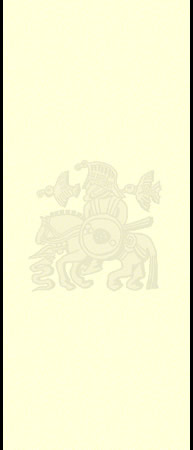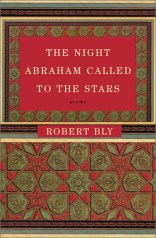



| Web site design and maintenance by Akikaze Media Services. All content of this site, unless otherwise noted, is copyright ©2001 Robert Bly. All Rights Reserved. Any duplication, in any form without the written consent of the copyright holder is prohibited. |

By Andy Brumer
Robert Bly’s collection of poems, The Night Abraham Called to the Stars, presents his characteristically alert, daring and personal verse, only this time in the ghazal tradition. In an essay that accompanied one such poem in The Minneapolis Star Tribune, Bly wrote: "the ghazal . . . began as a love poem in Arabic in the 10th century, and the word actually means ‘love poem.’ Since then the subject matter has broadened and the ghazal has become the major poetic form in a number of languages such as Urdu, Farsi, and Hindi." The book jacket’s copy states that "in the ghazal, each stanza is an independent poem, so the writer is able to shift landscapes. One stanza may have a reference to myth, the next a meditation on conscience. . . ."
The poems point, perhaps obliquely, to Bly’s many translations. In fact, in a somewhat curious book design decision, all the poems in this book occupy the right-hand pages, while the left side remains blank. It is as if they held in the "fertile bareness" (Wallace Stevens’ phrase) the specter of an original text that has crossed the threshold into being. The stark conceptual formality suggested by this typography, however, quickly becomes subsumed into Bly’s athletic leaps of language, imagery, and feeling and the uninhibited energy that powers the pages forward. The ghazal is a highly structured form made up of 36-syllable units divided into two 18-syllable lines. Bly has said that because lines longer than 12 or 14 syllables don’t work well in English, he opted for three 12-syllable lines.
Both the Old Testament and the Koran have many stories about Abraham whom history regards as the spiritual founder of Judaism, Christianity and Islam. Taking into account the events of the day, the poetic meshing of these three religions serves as a metaphor for the political healing the world needs right away. The number three also works spiritually as the "transcendent third" or the imaginative option that resolves and unlocks the intransigence and/or ambivalence caught between two ideological, intellectual or emotional poles. The attraction to our longing for transcendence makes its appearance in the very first lines of the book’s first and title poem, which represent an instance actually found in the Koran:
Do you remember the night Abraham first called
To the stars? He cried to Saturn: "You are my Lord!" . . .
Bly is reminding us that the Jewish Abraham could not have said, "Yahweh, you are my Lord," because the first Jews could not say God’s name out loud. This cry to heaven reflects the human instinct and genius for finding (or imagining) patterns in chaos, which goes by the name of making art. The human voice, when calling to the stars, moves vertically until it rebounds off the stars and spreads horizontally, like water splashing on a table. Bly has expressed this thought before. The "spirit" moves upward and resembles fire, he has written, while the "soul" descends downward, like water. It is a measure of the book’s fullness that both spirit and soul receive equal weight . . . and lightness here.
Actually, Bly assigns two seemingly irreconcilable symbols to the soul’s downward, earthly percolation and the spirit’s aspiring quest for perfection: the badger and the bride. Like Bly, the badger lives in the upper midwest. The "bride," which introduces Bly’s long interest in Jungian thought (more specifically, Jung’s "anima" or the unconscious feminine component of a man’s psyche) provides access to the unconscious itself. Again, the first poem, in the space of two lines, leaps or falls from heaven back to earth:
We are faithful companions to the unfaithful stars
We are diggers, like badgers: we love to feel
The dirt flying out from behind our hind claws.
In this stanza, the feminine and the badger, the spirit and the soul, confront each other directly
"I was climbing on the sounds of my lover’s
Name toward God," Iseult said. "Then a badger ran past.
When I said, ‘Oh badger,’ I fell to earth."
The sense is that the badger humbled, or perhaps astonished Iseult back from the sometimes detached aspirations of spiritual longing and returned her squarely to both earth and herself.
Actually, Bly uses many animals in these poems; the donkey, the oyster, the crow and various other birds, fish, the cow, and horses among others, many others, in their innocence, their instinctiveness and their mortality, pointing to the soul’s gravity.
In "Pitzeem and the Mare," Bly writes:
. . . Friends
Our desire to reach our true wife is great,
But the mare’s love for her child is also great. Please
Understand this. The journey was a three-day trip,
But it took Pitzeem thirty years. You and I have been
Riding for years, but we’re still only a day from home.
This "thirty years" may not represent compressed or "fairy tale" time. It often takes a man or woman, after one trauma or another, that long to regain the capacity to love and to feel.
Later (in "So Be It: Amen") Bly weds the badger and the bride in a surrealistic stanza, which nevertheless sternly expresses a truth:
We always want to intervene when we hear
That the badger is marrying the wrong person,
But the best thing to say at a wedding is "Amen."
Bly sprinkles these poems with biblical, literary, historical and art historical personages, which he composes and juxtaposes like images at play in a cubist painting. Bly’s pages, then, become stretched canvases from which skeins of feeling rise in layers, as in the following examples:
Plato wrote by the light from sharks’ teeth . . .
Plato, in love with the novelty of abstract thought, must have felt relieved to realize that "shark tooth light" was only a metaphor.
The two lovers watch Charlie Chaplin eat his shoe,
And a moment later find themselves barefooted in the grave. . .
Chaplin integrates the essence of comedy and tragedy, and these lines ask us whether a man eating his shoe is funny or sad. Of course it is both. It’s hilarious in a wholesome slapstick kind of way, and heart wrenchingly pathetic in its dumb futileness. The doubled grief of the lovers, watching their own and their beloved’s life race by is undeniably sorrowful. Yet one thinks of Dylan Thomas’s line, "Though lovers be lost love shall not," from "And Death Shall Have No Dominion," and finds comfort in the thought of love’s collective joy and enduring rhythm.
The figures in these poems come to feel like Bly’s friends, whose life-long companionship and presence feels holy:
There are people who don’t want Kierkegaard to be
A humpback, and they’re looking for a wife for Cezanne.
It’s hard for them to say, "So be it. Amen."
There is a lot of confession in this book, a sense of setting the record straight. Here Bly confesses to the archetypal confessionalist and three problematic precursors:
One teaspon of envy was enough for me
To attack Robert Lowell; with a tablespoon
I could have taken on Henry James and Abelard.
Bly is an acrobat because he’s always losing his balance alone and falling down. One of the pleasures of reading his work is to watch him pick himself up, dust himself off and tell of what his tumbling turned up and taught him. In this mode Bly, like the Abstract Expressionists (Jackson Pollock), embodies the idea of the "artist as hero." We think of Charlie Chaplin again, regaining his equilibrium after the two-by-four clobbers him in the head:
It’s all right if we tumble down the falls.
I remember how many lambs died on the farm.
Our desires reform themselves overnight anyway . . .
Again, the leaping throughout these ghazals is astonishing.
The last quote came from "The Raft of Green Logs," a poem in which Bly reflects on the rigors of writing poetry. It ends:
My affections were stuffed into the giant’s mouth.
Some marriages are rafts. I saw water between
The green logs. You could not have saved me.
Many enter romances and/or marriages with the hope and expectation that the relationship will "save" them. In the end, a "marriage" is not a ride, but a long journey toward recognizing and loving another and one’s own individuality and loneliness. In the end, poets and their poems can only save themselves.
To feel the image and structure of these ghazals, one has to experience them as whole works. Here is "The Raft of Green Logs," already quoted in parts, in its entirety:
Poetry is an occupation appropriate for slaughterers
And knife-wielders. Life on earth needs many kills
To engender the soft leaps of the cheetah.
God made me tender; but writing poetry,
With its furry herd of images that have
To be saved or murdered, has made me fierce.
The Lord of this World condemns half his friends
to death. Music testifies to that. Notes
Wave their arms and sink into the cold Atlantic.
During the years I called to Rilke and Boehme,
I hung on to small branches; I went over
The waterfall still holding the twig of reason.
It’s all right if we tumble down the falls.
I remember how many lambs died on the farm.
Our desires reform themselves overnight anyway.
My affections were stuffed into the giant’s mouth.
Some marriages are rafts. I saw water between
The green logs. You could not have saved me.
—Reprinted from Poetry Flash